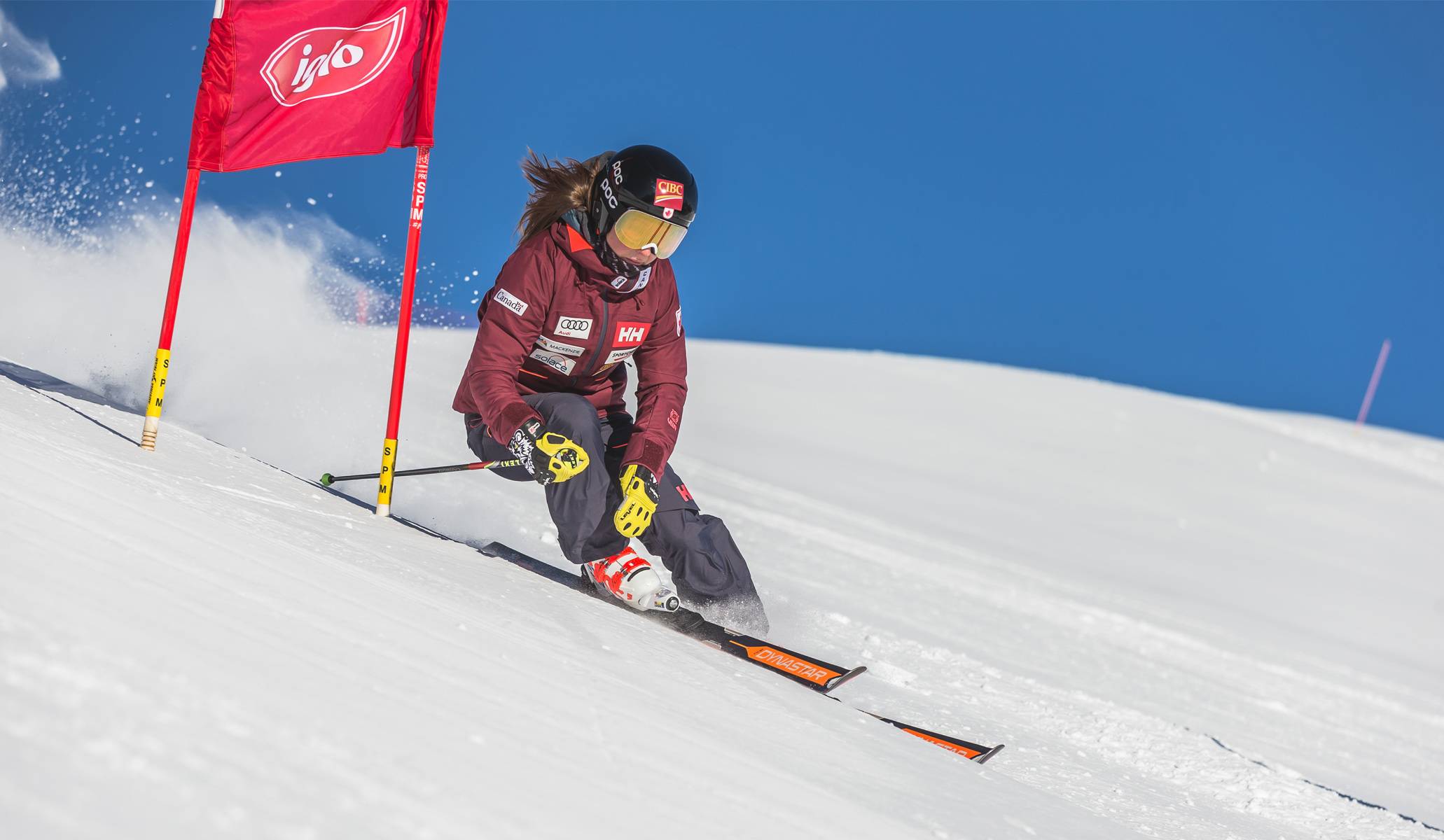Train to Race
BUILD THE SKI RACER & OPTIMIZE THE ENGINE
Ski racers demonstrate outside ski pressure throughout the turn and develop the ability to manipulate the ski orientation on the snow through the maintenance of a good athletic ready position on skis while carving in a variety of environments.
Continue to create fun and challenging environments where ski racers can refine and maintain their foundational technical skiing skills in a variety of course configurations and terrain in preparation for competition. Make the whole run count every time; when setting drill courses, set multiple environments on one trail if possible.
- Boys After adolescent growth period
- Girls After adolescent growth period
- Dependent on skiing skills & fitness
- Club through Provincial Team Level

TECHNICAL FOCUS
Ski racers demonstrate outside ski pressure throughout the turn and develop the ability to manipulate the ski orientation on the snow through the maintenance of a good athletic ready position on skis while carving in a variety of environments.
- Ankles flexed (tension) resulting in shin pressure on the front of the boot with knees driving towards the ski tips. Shin pressure allows the hips (COM) to be over the feet resulting in the best position for success.
- Parallel skis with hip to shoulder width stance.
- Everything is inline including the ski tips, bindings, knees, shoulders.
- Hips are perpendicular to the skis.
- Body movement between turns and over terrain is forward, moving with the skis through transitions.
- Ski racers are proficient at weight transfer between symmetrical turns to enable the ski racer to carve on the outside ski.
- Ski racers experiment with different edge angles on the steep and flat terrain.
- Upper body should remain stable and quiet.
- Proper upper and lower body separation is used to direct forces to the outside ski resulting in a stable platform.
- Pole plant timing and coordination will become more consolidated and disciplined.
Ski racers must maintain the correct body position on the skis at all times!
- Ski racers should practice carving turns outside ski to outside ski and one ski skiing to refine the fundamental skiing skill of carving a turn with the proper upper and lower body separation and forward body position on the ski through the use of ankle flexion to promote the establishment of a platform utilized to apply force to the ski.
- Ski racers learn to control and generate speed through the use of different turn shapes, short and long radius turns, on all types of terrain.
- Ski racers continue to perform technical free ski skills with control and rhythm in a variety of different environments.
- Changing one variable from one run to another adds contrast and allows drill repetition without repeating.
- Ski racers refine their speed skills including tucking, gliding and jumping skills over natural terrain, platform jumps, terrain park and ski cross features.
- Ski racers should train full ski cross courses and the speed disciplines of Super G and Downhill.
Focus on maintaining a good technical skiing foundation, this is a required component of the ski racers training program. Frequent technical free ski sessions are encouraged.
IN THE WINTER MONTHS, SKI RACERS SHOULD STRIVE TO ATTAIN A MINIMUM OF 100+ DAYS ON SNOW BY PARTICIPATING IN A STRUCTURED SKI RACING PROGRAM. SKI RACERS SEEKING THE COMPETITIVE PATHWAY WILL REQUIRE SIGNIFICANTLY MORE TIME ON SNOW THAN THE RECOMMENDED MINIMUM NUMBERS OF DAY ON SNOW.
TACTICAL FOCUS
Continue to create fun and challenging environments where ski racers can refine and maintain their foundational technical skiing skills in a variety of course configurations and terrain in preparation for competition. Make the whole run count every time; when setting drill courses, set multiple environments on one trail if possible.
- Continue to focus on the importance of "line" in ski racing through the use of tactical course sets that appropriately challenge the ski racer.
- Continue to work on the tactical application of foundational technical skiing skills in open rhythmical/arrthythmical giant slalom and slalom courses with rolling terrain.
- Course sets that cause ski racers to move over terrain, including blind gates, is encouraged. Learning how to keep the skis on the snow in a variety of terrain changes is a ski racing skill.
- Set courses through rolling terrain where ski racers need to turn over rolls and generate speed in all disciplines; ski fall-away turns.
- Start training is encouraged. Train with a variety of start ramp angles with a variety of ski lengths.
- Foster good inspection skills during training through the use of race simulations or time-trials.
- Training environments should promote self-discovery by the ski racer where the ski racer can analyze an error and try a different tactic without a significant amount of feedback.
- Continue to refine the execution of gliding and glide turns with Super-G and Downhill courses to promote comfort at speed.
- Terrain used for developing jumping skills becomes progressively bigger; aim for at least a 10m distance at 1-2m above ground flight.
- Change training venues as often as possible to add variation and fun!
- Ski racers are encouraged to use the whole mountain as their playground and explore every terrain feature.
- Failure is part of the learning process if the ski racers are pushing their limits in training and competition, they will fail but can learn from their mistakes with the proper mindset.
Ski racers should be encouraged to train in a variety of environments including:
- Course setting on various terrain is encouraged.
- Change training venues as often as possible to add variation.
- Course sets should create the opportunity for ski racer self-discovery.
- Set on easy, moderate, and steep terrain. Terrain should be used as a self-discovery tool.
- Course sets should include competition simulation.
Course sets include the following events:
- Giant Slalom
- Slalom
- Super Giant Slalom
- Downhill
- Alpine Combined
- Parallel Slalom and Giant Slalom
- Dual Formats/Team Event
- Introduce simple Ski Cross courses and begin to develop the ability to ski in traffic and awareness of surroundings when skiing.
Set regulation sized Super G and Downhill courses; ski on longer skis throughout the year to practice:
- Glide turns
- Jump progressions
- Movement over terrain with speed


